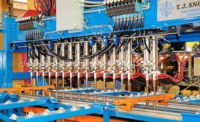Automated Spot Welding Improves Assembly of Barbecue Grills




Since 1937, Robert H. Peterson Co. in California has produced Fire Magic gas grills and Real-Fyre gas logs. Over the years, the company has grown steadily and their commitment to quality and craftsmanship has not changed.
What has changed is the company’s approach to manufacturing. The company has shifted from single-station operations with a one man per machine orientation, to more automation in fabrication and assembly. The 230,000-square-foot facility houses every facet of the manufacturing process.
As part of the continuous flow manufacturing line for the Echelon and Aurora gas grills, R.H. Peterson looked to Contour-Arc Inc., a local integrator of robotic and automated welding systems, for a custom CNC-controlled spot welding system. The custom machine needed to automatically weld large, stainless steel firebox assemblies while also integrating directly into the company’s continuous flow line of fabrication, assembly, test and packaging operations.
The CNC Spot Welding System consists of four independent welding stations attached to tow oscillating rotary tables placed side by side. The system is governed by a Siemens Sinumerik 802D CNC control, which provides three axes of coordinated motion, and the Miyachi Unitek IS-120B Inverter Spot Welding Power Supply.
According to Contour-Arc president Steven Pfahl, this configuration allows the operator to safely load the fixtures on one side while the machine is welding on the other side, maximizing the system’s production time and minimizing machine idle time. The Sinumerik 802D controls and monitors all functions of the machine, including the spot welding process.
To facilitate the different material thicknesses of these firebox assemblies, the CNC interfaces seamlessly with the Miyachi IS-120B power supply so the programmer can call up any number of pre-programmed weld schedules stored in the weld controller and use them when needed.
The typical welding program can be written in less than one hour. Siemens also provided on-site training at R.H Peterson’s facility to help train the company’s personnel on how to write programs using the remote pendant or the control panel, and how to back up and store machine data.
To complete this system, Contour-Arc designed and built custom part-holding fixtures that were needed to assure the combined time of part loading and unloading would be less than the weld cycle time. The firebox comprises several irregular shaped sheet metal components, with the welding being done completely around the perimeter of the assembly.
A typical assembly has 50 spot-welds on each side of the firebox, with each fixture holding both sides simultaneously. Because of the shape of the assembly, mechanical clamps would either interfere with the welding head or with the loading and removing of the finished assembly from the fixture. Vacuum clamping is used instead.
“The advantage of the vacuum clamping system is that the operator can load and unload the fixtures in a matter of seconds and nothing gets in the way of the machine’s welding head and electrode,” says Pfahl. “This allows us to run the machine at its maximum speed. We also programmed the CNC to monitor vacuum sensors placed in the fixtures, so if the vacuum level falls below the minimum set-point, machine motion will stop and an alarm will display on the control panel.”
All the fixtures are quick-change style with locating pins and quick disconnect electrical and vacuum fittings. The system’s configuration allows the fixtures to be changed on one index table while the robot is welding at the other, again reducing system idle time and maximizing the production on each shift. R.H. Peterson reports time savings up to 30 percent.
“On the floor, we run eight different grill sizes of three different models,” explains Jon Bridgwater, senior vice president of R.H Peterson. “Once we set up the four programs, no additional programming was needed. This system has allowed us complete flexibility in the models, sizes, and quantities we can run at any time. This is the ultimate in lean manufacturing.”
For more information on CNC controls, call Siemens at 800-241-4453 or visit www.siemens.com.
Looking for a reprint of this article?
From high-res PDFs to custom plaques, order your copy today!






